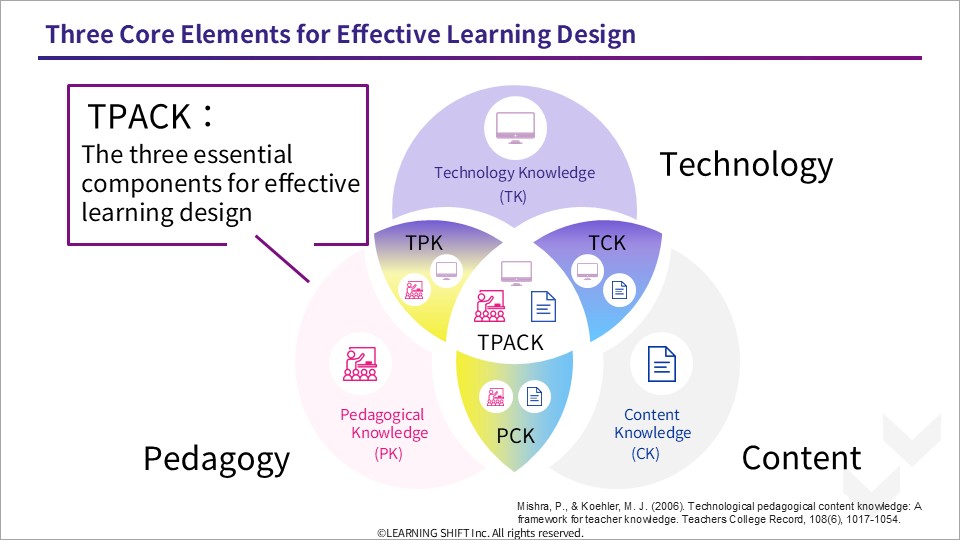2022.02.05
The Key to Linking Learning with Business Success: Understanding TPACK

To maximize the effectiveness of blended learning, organizations must first understand the foundational framework for designing effective learning experiences. One of the most crucial concepts in this regard is TPACK (Technological Pedagogical Content Knowledge).
This article provides a clear overview of TPACK's definition, historical background, and key implementation strategies to help organizations optimize their corporate training programs.
1. What is the Purpose of Learning in Corporate Training?
Why do companies invest in training their employees?
The primary goal is to ensure the successful execution of business strategies and drive revenue growth.
In today’s business landscape, companies must create new value and maintain a competitive edge. The key to achieving this lies in enhancing employee performance, which is why corporate training plays a critical role in talent development.
Companies view training as an investment in their employees. They expect that by developing employees’ skills and improving overall organizational performance, they can strengthen their competitive position in the market.
To ensure a return on investment in training, companies must effectively measure its impact. Performance measurement is essential for evaluating training effectiveness and determining whether it truly contributes to business success.
One of the most well-known training evaluation models is Kirkpatrick’s Four-Level Evaluation Model, developed in the 1950s.

The Four Levels of Kirkpatrick’s Model:
Level 1: Reaction
【Purpose】 Evaluate participant satisfaction with the training
【Methods】 Surveys, action plans
Level 2: Learning
【Purpose】 Assess the extent of knowledge and skill acquisition
【Methods】 Written tests, reports, discussions
Level 3: Behavior
【Purpose】 Determine whether employees apply their learning in the workplace
【Methods】 Checklists, interviews, follow-up surveys
Level 4: Results
【Purpose】 Measure the overall impact on business performance
【Methods】 Quantitative and qualitative data analysis
While many organizations conduct Level 1 and Level 2 assessments, Level 3 and Level 4 evaluations remain challenging due to the complexity of tracking behavioral changes and linking training outcomes to business metrics.
On the other hand, Levels 3 and 4 are more difficult to achieve because they require knowledge of instructional design, which involves repeated processes of analysis, design, development, and implementation to create effective training.
Currently, many organizations are striving to implement Level 3, but most have not reached Level 4.
2. What is TPACK? (Understanding TK, CK, and PK)

TPACK stands for Technological Pedagogical Content Knowledge, which integrates three key elements:
- Technological Knowledge (TK) – Understanding and effectively using technology in training
- Content Knowledge (CK) – Creating high-quality learning content aligned with business goals
- Pedagogical Knowledge (PK) – Applying instructional design principles to optimize learning effectiveness
These three components must work together to create a balanced and effective learning experience.
The meaning of each component is as follows.
TK (Technological Knowledge)
In corporate learning, Technological Knowledge refers to understanding technology and how to use it effectively.
This includes knowledge and mindset related to the devices and platforms essential for training, such as video streaming services, web tools, and systems suited to different learning scenarios.
TK involves being aware of the various technologies available for delivering training and thinking critically about how to use and differentiate between them.
CK (Content Knowledge)
Content Knowledge here refers to the ability to create and edit learning materials that lead to real outcomes.
Offline and online training have different characteristics, and the key to maximizing learning effects varies accordingly.
Especially with the rapid development of online training, new technologies such as video editing, filming techniques, and content curation are becoming essential for producing effective learning content.
Creating high-quality content tailored to the purpose of each learning activity is at the heart of CK.
PK (Pedagogical Knowledge)
Pedagogical Knowledge connects TK and CK.
This encompasses broad educational theories and teaching methods, including scientifically proven learning approaches and course design that reflects them.
PK covers:
- how to design learning experiences for high effectiveness
- how to enhance learner motivation
—providing the foundation for thoughtful training design.
In this way, TPACK emphasizes the importance of integrating Technology, Content, and Pedagogy.
The strength of TPACK lies in its ability to combine these three elements to design training programs that lead to meaningful results.
3. The History of TPACK
The roots of TPACK can be traced back to Pedagogical Content Knowledge (PCK), a concept introduced by Lee Shulman in 1985.
Shulman argued that teaching effectiveness depends on the integration of pedagogy (how to teach) and content (what to teach). His work emphasized the importance of balancing instructional methods with subject matter expertise.
In the early 2000s, Punya Mishra and Matthew Koehler expanded Shulman’s framework by incorporating technology into the equation, resulting in the development of TPCK (later simplified to TPACK).
TPACK continues to evolve as a framework for optimizing modern learning experiences, particularly in digital and blended learning environments.
Today, TPACK supports purposeful learning design by integrating content, pedagogy, and technology.
For example, e-learning reflects TCK (Technology + Content), where technology broadens content delivery.
Other combinations, such as PCK (Pedagogy + Content) and TPK (Technology + Pedagogy), also contribute to effective instructional design.
4. Key Considerations for Implementing TPACK
TPACK was originally developed as a theory for school education. Therefore, directly applying it to corporate training requires an adaptation to business needs.
So how can organizations integrate TPACK into their training programs? The key is to combine all three elements effectively.
Since TPACK consists of distinct components, prioritizing only one aspect may limit its overall effectiveness. For example, while pedagogical knowledge (PK) is essential, strong content (CK) and the right technology (TK) are also necessary to create a well-rounded learning experience.
Practical application of TPACK in corporate training involves:
- Designing courses and facilitation based on pedagogical principles
- Selecting appropriate technologies and tools for delivery
- Developing engaging and effective content aligned with learning goals
を検討していきます。
Additionally, two important perspectives should be considered when applying TPACK:
①Focusing on improving knowledge retention in training
②Aligning with the characteristics of adult learning
Let’s take a closer look at each of these perspectives.
#1. Enhancing learning retention in training programs
In this context, “retention rate” refers to the measurable degree of knowledge absorption resulting from learning.
Focusing on improving retention means considering how to effectively combine the elements of TPACK to enhance learning outcomes.
One well-known concept for boosting retention is the Learning Pyramid, a model that illustrates different learning methods and their estimated retention rates in a pyramid format.
(Note: While the scientific validity of this model is debated, it is referenced here for its suggestive value.)

The Learning Pyramid illustrates learning methods in order of retention rate, from highest at the bottom to lowest at the top.
From this, we can conclude that active learning involving output—such as discussions or practice—is particularly effective for improving retention.
However, even within “lectures,” the retention rate can vary depending on how they are delivered, so active learning is not always the best approach in every case.
Rather than sticking to a single learning method, combining multiple approaches tends to be more effective.
This idea of blending different learning methods is embodied in blended learning—and at the core of this approach lies the TPACK framework.
#2. Aligning with the characteristics of adult learning (P-MARGE Model)
To design training programs that are likely to improve performance, it is essential to consider how adults tend to learn in the workplace.
“P-MARGE” is an acronym that represents key characteristics of adult learning.
- Practical (content should be directly applicable to work)
- Motivation (intrinsic and extrinsic motivation should be incorporated)
- Autonomous (learners should have some control over their learning process)
- Relevancy (training should be job-related)
- Goal-oriented (clear objectives should be set)
- Experience (use real-world case studies and examples)
When considering the P-MARGE model, certain trends in effective learning design become clear—such as:
・Creating content with a focus on practicality and relevance to the learner’s work
・Designing training programs based on established learning theories
Now let’s see how TPACK can be applied here.
For example, by leveraging Pedagogical Knowledge (PK), you can incorporate elements like:
- LXD (Learner Experience Design)
- Instructional design based on learning stages (before, during, and after the session)
- Mechanisms to promote continued learning(such as gamification and behavioral triggers)
By considering these factors, organizations can effectively integrate TPACK into corporate training.
5. Conclusion: Leveraging TPACKfor Successful Corporate Training!
Understanding TPACK and applying effective training evaluation methods is essential for designing training programs that improve employee performance.
When designing corporate training, it is important to use TPACK as an integrated framework rather than treating its components separately.
The success of corporate training can be measured by evaluating improvements in employee performance. By leveraging TPACK and implementing effective performance measurement, organizations can design high-impact training programs that drive business success.